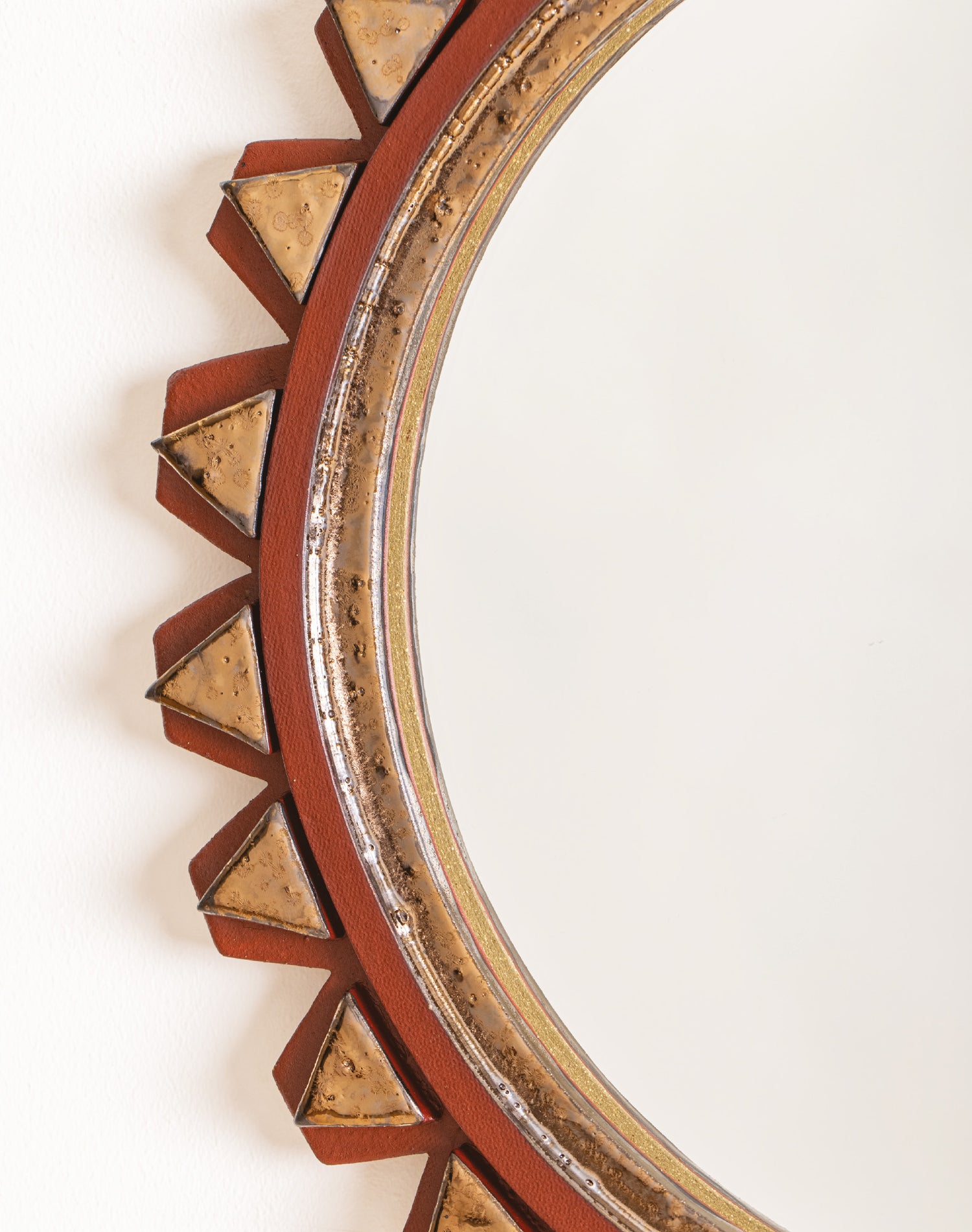
COLLECTION 1
It began as you’d expect. The Paul Bert Flea Market in Paris. Fabulous things. Abounding inspiration. The return home and the eventual rumination on a single piece, a small wall hanging made of rectilinear clay paillettes carefully tied together. This is followed by flipping through favorite books and seeing the similarities in the textures and tactility of Anni Albers’s tapestries, which leads to Josef’s tessellating fireplaces and Eileen Gray’s graphic screens.
This collection is a tribute to these individuals. Composed of two folding screens, two tables, a pair of sconces, and a lamp, it is a study of order and relation, a study of design as Josef Albers would say. Patterns were developed, applied to the different pieces, and then mixed and remixed to achieve the most pleasing combinations. And, in a first for the studio, blackened steel was introduced, its smooth delicacy heightening the character of the clay.
Together, these pieces speak to one another through their playful contrasts, as well as their ultramarine interiors. Separately, they stand on their own (quite literally in the case of the table and screen), unpretentious objects that will be at home in spaces for years to come.
-

A necklace by Anni Albers made from found objects. Anni’s use of everyday items in her jewelry, such as aluminum washers, clips, drain strainers, and ball chains, served as inspiration for the collection’s metalwork.
-

Josef’s ‘Upward’ (1926), made from sandblasted, flashed glass which was then back painted. This ultramarine undercoating finds its way into the collection’s screens, lamps, and tables.
-

One of several maquettes for a brick fireplace that Josef Albers designed for a house in Bethany, CT.
-

The Tall Cassette Folding Screen measures 68 inches tall, while the Short Cassette Folding Screen measures 50 inches tall. Both measure 68 inches wide.
-

Each ceramic panel slots individually into the blackened steel frame, allowing the overall composition to vary from screen to screen.
-

Radiator Sconce #1 and Radiator Sconce #2, fraternal twins glazed in a combination of Walnut and Ochre
-

Quadrangle Table Lamp in Matte-Black.
-

Quadrangle Table Lamp in Parchment and Ultramarine
-

Left, the Capsule Side Table in Mushroom with Ultramarine interior. Right, the Capsule Side Table in dipped Parchment.
-

Detail of the Parchment glaze, which gives the table a more everyday finish.
-

Each side table is assembled from two pieces that are fired separately and then joined after glazing.

COLLECTION 2
Each of our pieces is shaped by hand. The clay is cut and cajoled, coated and corded. It’s why they vary slightly, their character the product of the day’s temperament. Yet, few pieces are designed to be handled regularly. They sit handsomely on surfaces, but are rarely picked up, turned over, and explored.
The desire to create something that formed part of a personal routine, something precious, led us to the French ceramicist and jewelry designer Mithé Espelt and, ultimately, the creation of this collection. Born in 1923, Espelt is known for her mirrors, boxes, and jewelry — small, whimsical treasures to be used as part of the everyday act of dressing.
Our mirrors and tables are a nod to her carved geometries, employing the studio’s signature slab technique to create a series of inlaid patterns. They also take Espelt’s combination of color and gilt and render it in decidedly Dumais Made shades (think rich and patinated rather than bright and radiant). The result? Precious, everyday objects that add shimmer to daily life.
-

A few of Espelt’s first mirrors (c. 1948) in her signature gold gilt.
-

Three small boxes made by Espelt between 1966 and 1976. Their patterns, which Espelt typically embossed or carved onto the piece, were the starting point for the collection’s in-laid medallions.
-

Two wall mirrors by Mithé Espelt c. 1958: ‘Barrettes’, on the left, and ‘Oval’, on the right.
-

Hanging from top to bottom: the Flammes Hand Mirror in Cracked Gold and Chalk, the Perles Hand Mirror in Cracked Gold, and the Flammes Hand Mirror in Cracked Gold. A Perles Hand Mirror in Cracked Gold and Lead rests on a book of Pablo Picasso’s linogravures.
-

Lagon Hand Mirror in Cracked Gold and Navy
-

Ray Hand Mirror in Mushroom and Cracked Gold
-

A detail of the Ouvéa Wall Mirror.
-

Ouvéa Wall Mirror in Parchment and Cracked Gold
-

Cirque Wall Mirror in Verdigris. Here, layers of glaze are repeatedly hand-painted onto each medallion to achieve the difference in color.
-

Anemone Wall Mirror in Parchment and Cracked Gold
-

Rayons Wall Mirror in Sienna and Cracked Gold
-

Monaco Wall Mirror in Cracked Gold
-

Four Helene Side Tables feature in the collection, each with a unique surface treatment. From left to right, Helene Side Table in Carriage Red and Cracked Gold, Helene Side Table in Cracked Gold, Helene Side Table in Lichen, and Helene Side Table in Lichen and Cracked Gold.
-

Detail of the Carriage Red and Cracked Gold glaze.
-

Detail of the Cracked Gold and Sienna glaze.
-

Grace Table Lamp in Cracked Gold. The top of the lamp is glazed in Sienna, which pairs with the rust linen shade.
-

Grace Table Lamp in Cracked Gold. This time, however, both the top of the lamp and the shade are rendered in Ultramarine.
-

Detail of the Cracked Gold and Ultramarine glaze.

COLLECTION 3
The power of an introduction is not to be underestimated. For the Californian sculptor JB Blunk, it was a chance meeting with Isamu Noguchi, who subsequently introduced him to the renowned Japanese potters Kitaōji Rosanjin and Kaneshige Toyo, as well as surrealist painter and eventual patron Gordon Onslow-Ford. All influential figures that shifted his creative perspective.
For us, it was the introduction to Blunk’s work by a close friend and client. Everything Blunk did, from his wood burl sculptures to his cups and plates, to the house he built for his family, sought to express the spirit of the material that he was working with. If a pot decided to buckle as it dried, he left it. If a wood burl curved a certain way as it was carved, he embraced it.
The lamps and vases that form this collection are an homage to Blunk’s approach. Pendants and torchieres in rich, deep glazes, look as if they’ve experienced a beautiful wobble while on the wheel. While the totemic floor and table lamps, with their repeating kit of parts, have been glazed to enhance the clay’s subtle textures. Figurative yet abstract, they are a new way of looking at our familiar forms.
-

JB Blunk honing his craft at the studio of Living National Treasure, Toyo Kaneshige, in 1952.
-

Three views on ‘Column #5’ (1982), a sculpture made from redwood that has been stained black with shoe polish.
-

Two of Blunk’s ceramics from 1953, both highlighting the natural textures and aberrations that he preserved in his pieces.
-

Bizen Pendant in Verdigris
-

From left to right, the Bizen Vase in Verdigris, the Bizen Torchiere in Matte-Black and Lead, and the Bizen Torchiere in Walnut and Chalk.
-

From left to right, the Dyad #1 Table Lamp in Parchment, the Dyad #2 Table Lamp in Parchment, the Dyad #2 Vase in Chalk, and the Tetrad Floor Lamp in Parchment and Chalk.
-

The Dyad and Tetrad pieces are composed of a kit of parts that are fired separately and then stacked one on top of the other to create their totemic forms.
-

Dyad #1 Table Lamp in Parchment
-

Dyad #2 Table Lamp in Parchment
-

Blunk Table Lamp in Lichen
-

The Lichen glaze is repeatedly poured over the lamp’s surface to build up the pebbled texture, which is created by flecks of copper oxidizing in the kiln.
-

From left to right: the Triad Floor Lamp in Matte-Black and Bottle Green, the Dyad #1 Vase in Matte-Black, and the Tetrad Floor Lamp in Parchment and Chalk
-

Triad Floor Lamp in Matte-Black and Bottle Green










































